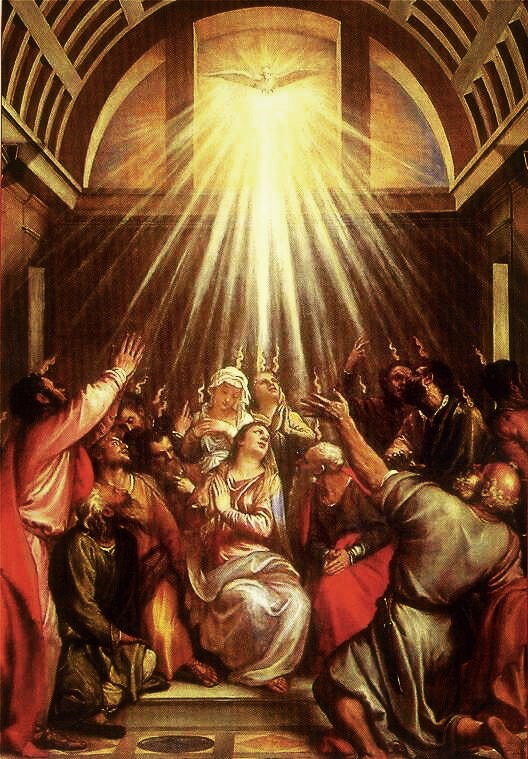PENTECOST is not only a single event, but a grace that the Church can experience again and again. However, in this past century, the popes have been praying not only for a renewal in the Holy Spirit, but for a “new Pentecost”. When one considers all the signs of the times that have accompanied this prayer—key among them the continued presence of the Blessed Mother gathering with her children on earth through ongoing apparitions, as though she were once again in the “upper room” with the Apostles… the words of the Catechism take on a new sense of immediacy:
…at the “end time” the Lord’s Spirit will renew the hearts of men, engraving a new law in them. He will gather and reconcile the scattered and divided peoples; he will transform the first creation, and God will dwell there with men in peace. —Catechism of the Catholic Church, n. 715
This time when the Spirit comes to “renew the face of the earth” is the period, after the death of Antichrist, during what the Church Father’s pointed to in St. John’s Apocalypse as the “thousand year” era when Satan is chained in the abyss.
He seized the dragon, the ancient serpent, which is the Devil or Satan, and tied it up for a thousand years… [the martyrs] came to life and they reigned with Christ for a thousand years. The rest of the dead did not come to life until the thousand years were over. This is the first resurrection. (Rev 20:2-5); cf. The Coming Resurrection
So, the blessing foretold undoubtedly refers to the time of His Kingdom, when the just will rule on rising from the dead; when creation, reborn and freed from bondage, will yield an abundance of foods of all kinds from the heaven’s dew and the fertility of the earth, just as the seniors recall. Those who saw John, the Lord’s disciple, [tell us] that they heard from him how the Lord taught and spoke about these times… —St. Irenaeus of Lyons, Church Father (140–202 A.D.); Adversus Haereses, Irenaeus of Lyons, V.33.3.4, The Fathers of the Church, CIMA Publishing Co.; (St. Irenaeus was a student of St. Polycarp, who knew and learned from the Apostle John and was later consecrated bishop of Smyrna by John.)
Unlike the heresy of millenarianism which held that Christ would literally come to reign on earth in His resurrected body amid lavish carnivals and feasts, the reign referred to here is spiritual in nature. Wrote St. Augustine:
Those who on the strength of this passage [Rev 20:1-6], have suspected that the first resurrection is future and bodily, have been moved, among
other things, specially by the number of a thousand years, as if it were a fit thing that the saints should thus enjoy a kind of Sabbath-rest during that period, a holy leisure after the labors of six thousand years since man was created… (and) there should follow on the completion of six thousand years, as of six days, a kind of seventh-day Sabbath in the succeeding thousand years… And this opinion would not be objectionable, if it were believed that the joys of the saints, in that Sabbath, shall be spiritual, and consequent on the presence of God… —St. Augustine of Hippo (354-430 A.D.; Church Doctor), De Civitate Dei, Bk. XX, Ch. 7, Catholic University of America Press
At the end of the six thousandth year, all wickedness must be abolished from the earth, and righteousness reign for a thousand years [Rev 20:6]… —Caecilius Firmianus Lactantius (250-317 A.D.; Ecclesiastical writer), The Divine Institutes, Vol 7.
This reign of Christ in an era of peace and justice comes by means of a new outpouring of the Holy Spirit—a Second Advent or Pentecost (see also The Coming Pentecost):
The Church cannot prepare for the new millennium “in any other way than in the Holy Spirit. What was accomplished by the power of the Holy Spirit ‘in the fullness of time’ can only through the Spirit’s power now emerge from the memory of the Church”. — POPE JOHN PAUL II, Tertio Millennio Adveniente, 1994, n. 44
THE RESTORATION OF ALL THINGS
In a statement that is both insightful and prophetic, Pope Leo XIII in 1897 initiated the following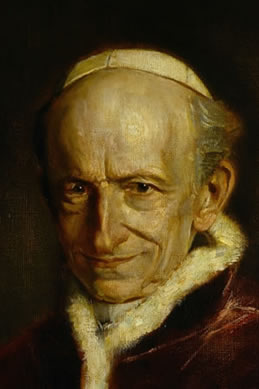 century of popes who would earnestly pray for a “new Pentecost.” Their prayers would be not just for a spiritual revival of sorts, but for the “restoration of all things in Christ.” [1]cf. POPE PIUS X, Encyclical E Supremi “On the Restoration of All Things in Christ” He indicated that the entire or “long” pontificate was not only drawing to its end (that is, the Church was entering the “last times”), but was moving toward “two chief ends.” One, I’ve already mentioned in Part I, was to promote the reunion of “those fallen away from the Catholic Church either by heresy or by schism….” [2]POPE LEO XIII, Divinum Illud Munus, n. 2 The second was to bring about…
century of popes who would earnestly pray for a “new Pentecost.” Their prayers would be not just for a spiritual revival of sorts, but for the “restoration of all things in Christ.” [1]cf. POPE PIUS X, Encyclical E Supremi “On the Restoration of All Things in Christ” He indicated that the entire or “long” pontificate was not only drawing to its end (that is, the Church was entering the “last times”), but was moving toward “two chief ends.” One, I’ve already mentioned in Part I, was to promote the reunion of “those fallen away from the Catholic Church either by heresy or by schism….” [2]POPE LEO XIII, Divinum Illud Munus, n. 2 The second was to bring about…
…the restoration, both in rulers and peoples, of the principles of the Christian life in civil and domestic society, since there is no true life for men except from Christ. —POPE LEO XIII, Divinum Illud Munus, n. 2
Thus, he initiated the Novena to the Holy Spirit to be prayed nine days before Pentecost by the entire Church, in communion with the Blessed Mother:
May she continue to strengthen our prayers with her suffrages, that, in the midst of all the stress and trouble of the nations, those divine prodigies may be happily revived by the Holy Ghost, which were foretold in the words of David: “Send forth Thy Spirit and they shall be created, and Thou shalt renew the face of the earth” (Ps. ciii., 30). —POPE LEO XIII, Divinum Illud Munus, n. 14
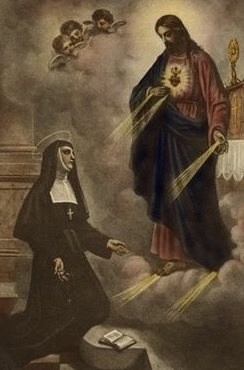 In the apparition of Jesus to St. Margaret Mary de Alacoque, she saw Jesus’s Sacred Heart aflame. This apparition, given as a “last effort” to mankind, [3]cf. The Last Effort ties together the devotion to the Sacred Heart with Pentecost when “tongues of fire” descended upon the Apostles. [4]cf. The Day of Difference Thus, it is no coincidence that Pope Leo XIII said this “restoration” in Christ would flow from “consecration” to the Sacred Heart, and that we should “expect extraordinary and lasting benefits for Christendom in the first place and also for the whole human race.” [5]Annum Sacrum, n. 1
In the apparition of Jesus to St. Margaret Mary de Alacoque, she saw Jesus’s Sacred Heart aflame. This apparition, given as a “last effort” to mankind, [3]cf. The Last Effort ties together the devotion to the Sacred Heart with Pentecost when “tongues of fire” descended upon the Apostles. [4]cf. The Day of Difference Thus, it is no coincidence that Pope Leo XIII said this “restoration” in Christ would flow from “consecration” to the Sacred Heart, and that we should “expect extraordinary and lasting benefits for Christendom in the first place and also for the whole human race.” [5]Annum Sacrum, n. 1
It will at length be possible that our many wounds be healed and all justice spring forth again with the hope of restored authority; that the splendors of peace be renewed, and the swords and arms drop from the hand and when all men shall acknowledge the empire of Christ and willingly obey His word, and every tongue shall confess that the Lord Jesus is in the Glory of the Father. —POPE LEO XIII, Annum Sacrum, On Consecration to the Sacred Heart, n. 11, May 1899
His successor, St. Pius X, expanded this hope in greater detail, echoing Christ’s words that the “gospel of the kingdom will be preached throughout the world as a witness to all nations,” [6]Matt 24:14 as well as the Fathers who taught that their would come a “sabbath rest” for the Church from her labors: [7]cf. Heb 4:9
And it will easily come about that when human respect has been driven out, and prejudices and doubting laid aside, large numbers will be won
to Christ, becoming in their turn promoters of His knowledge and love which are the road to true and solid happiness. Oh! when in every city and village the law of the Lord is faithfully observed, when respect is shown for sacred things, when the Sacraments are frequented, and the ordinances of Christian life fulfilled, there will certainly be no more need for us to labor further to see all things restored in Christ… And then? Then, at last, it will be clear to all that the Church, such as it was instituted by Christ, must enjoy full and entire liberty and independence from all foreign dominion. —POPE PIUS X, E Supremi, On the Restoration of All Things, n. 14
This restoration would also see creation experience a renewal of sorts, as the Psalmist prayed and Isaiah foretold. The Church Fathers spoke of this as well… [8]see Creation Reborn, Toward Paradise – Part I, Toward Paradise – Part II, and Back to Eden
The earth will open its fruitfulness and bring forth most abundant fruits of its own accord; the rocky mountains shall drip with honey; streams of wine shall run down, and rivers flow with milk; in short the world itself shall rejoice, and all nature exalt, being rescued and set free from the dominion of evil and impiety, and guilt and error. —Caecilius Firmianus Lactantius, The Divine Institutes
PRAYING FOR A NEW PENTECOST
In a continuous harmony in the Holy Spirit, the popes have continued this prayer for a new Pentecost:
We humbly implore the Holy Ghost, the Paraclete, that He may “graciously grant to the Church the gifts of unity and peace,” and may renew the face of the earth by a fresh outpouring of His charity for the salvation of all. —POPE BENEDICT XV, Pacem Dei Munus Pulcherrimum, May 23rd, 1920
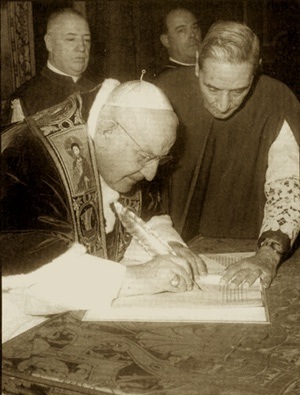 The first signs of this new Pentecost, of this “new springtime” for the Church and the world, began with the Second Vatican Council whom Pope John XXIII opened, praying:
The first signs of this new Pentecost, of this “new springtime” for the Church and the world, began with the Second Vatican Council whom Pope John XXIII opened, praying:
Divine Spirit, renew your wonders in this our age as in a new Pentecost, and grant that your Church, praying perseveringly and insistently with one heart and mind together with Mary, the Mother of Jesus, and guided by blessed Peter, may increase the reign of the Divine Savior, the reign of truth and justice, the reign of love and peace. Amen. —POPE JOHN XXIII, at convocation of Second Vatican Council, Humanae Salutis, December 25th, 1961
During the reign of Paul VI, during which the “Charismatic Renewal” was birthed, he said in anticipation of a new era:
The fresh breath of the Spirit, too, has come to awaken latent energies within the Church, to stir up dormant charisms, and to infuse a sense of vitality and joy. It is this sense of vitality and joy which makes the Church youthful and relevant in every age, and prompts her to proclaim joyously her eternal message to each new epoch. —POPE PAUL VI, A New Pentecost? by Cardinal Suenens, p. 88
With the pontificate of John Paul II, the Church heard over and over again the call to “open wide your hearts.” But open wide our hearts to what? The Holy Spirit:
Be open to Christ, welcome the Spirit, so that a new Pentecost may take place in every community! A new humanity, a joyful one, will arise from your midst; you will experience again the saving power of the Lord. —POPE JOHN PAUL II, in Latin America, 1992
Implying the difficulties that will come to humanity if it does not open itself to Christ, Blessed John Paul exhorted that:
…[a] new springtime of Christian life will be revealed by the Great Jubilee if Christians are docile to the action of the Holy Spirit… —POPE JOHN PAUL II, Tertio Millennio Adveniente, n. 18 (emphasis mine)
While still a Cardinal, Pope Benedict XVI said we are living in a “Pentecostal hour”, and indicated the kind of docility needed within the Church: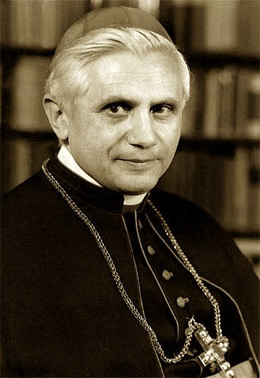
What is emerging here is a new generation of the Church which I am watching with a great hope. I find it marvelous that the Spirit is once more stronger than our programs… Our task—the task of the office-holders in the Church and of theologians—is to keep the door open to them, to prepare room for them….” —Cardinal Joseph Ratzinger with Vittorio Messori, The Ratzinger Report
The Charismatic Renewal and the outpouring of the gifts and charisms of the Holy Spirit were, he said, part of the first signs of this new springtime.
I am really a friend of movements—Communione e Liberazione, Focolare, and the Charismatic Renewal. I think this is a sign of the Springtime and of the presence of the Holy Spirit. —Cardinal Ratzinger (POPE BENEDICT XVI), Interview with Raymond Arroyo, EWTN, The World Over, September 5th, 2003
The gifts are also an anticipation of what is in store for the Church and the entire world:
By means of these gifts the soul is excited and encouraged to seek after and attain the evangelical beatitudes, which, like the flowers that come forth in the spring time, are the signs and harbingers of eternal beatitude. —POPE LEO XIII, Divinum Illud Munus, n. 9
The Era of Peace to come is in itself, then, an anticipation of Heaven by the fact that the gifts and graces of the Holy Spirit will increase exponentially so as to sanctify and prepare the Church, the Bride of Christ, to meet her Groom when He returns at the end of time in His final coming in glory. [9]cf. Wedding Preparations
THE COMING SANCTIFICATION
As was explained in Part V, what Jesus accomplished in the “fullness of time” through His Passion, Death and Resurrection remains to be brought to complete fruition in His mystical Body. Thus, we see in the pattern of His life the pattern that the Church must follow. So it is also in terms of Pentecost. Said St. Augustine:
He was pleased to prefigure His Church, in which those especially who are baptized receive the Holy Ghost. —On the Trinity, 1., xv., c. 26; Divinum Illud Munus, n. 4
Thus,
By the operation of the Holy Spirit, not only was the conception of Christ accomplished, but also the sanctification of His soul, which, in Holy Scripture, is called His “anointing” (Acts x., 38). —POPE LEO XIII, Divinum Illud Munus, n. 4
So too, the Church was conceived when she was overshadowed by 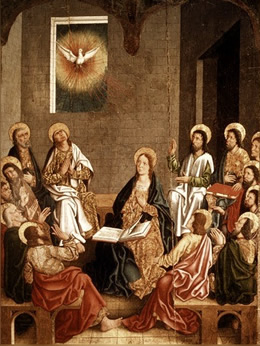 the Holy Spirit at Pentecost. But the “sanctification” of her soul remains a project of the Spirit that continues until the end of time. St. Paul describes the state of this sanctification that will precede the parousia, the return of Jesus at the end of time:
the Holy Spirit at Pentecost. But the “sanctification” of her soul remains a project of the Spirit that continues until the end of time. St. Paul describes the state of this sanctification that will precede the parousia, the return of Jesus at the end of time:
Husbands, love your wives, even as Christ loved the church and handed himself over for her to sanctify her, cleansing her by the bath of water with the word, that he might present to himself the church in splendor, without spot or wrinkle or any such thing, that she might be holy and without blemish. (Eph 5:25-27)
It is not that the Church will be perfect, for perfection is only accomplished in eternity. But sanctity is possible by living in a state of union with God through the grace of the Sanctifier, the Holy Spirit. The mystics, such as Stes. John of the Cross and Teresa of Avila, spoke about the progression of the interior life through purgative, illuminative, and finally unitive states with God. What will be accomplished in the Era of Peace will be a corporative unitive state with God. Of the Church in that era, St. Louis de Montfort wrote:
Towards the end of the world… Almighty God and His Holy Mother are to raise up great saints who will surpass in holiness most other saints as much as the cedars of Lebanon tower above little shrubs. —St. Louis de Montfort, True Devotion to Mary, Art. 47
It is for this that the Church is destined, and it will be accomplished through the “woman clothed with the sun” who labors to give birth to the whole body of Christ.
MARY AND THE NEW PENTECOST
Mary, as I have written elsewhere, is a prefigurement and mirror of the Church herself. She is the embodiment of the Church’s hope. Hence, she is also a key to understanding the plan of God in these last times. [10]cf. Key to the Woman She has been given not only as a model of and for the Church, but been made her Mother. As such, through her maternal intercession, she has been granted by the Father the profound role of distributing graces to the Church in the power of the Holy Spirit, through the mediation of her Son, Jesus.
This motherhood of Mary in the order of grace continues uninterruptedly from the consent which she loyally gave at the Annunciation and which she sustained without wavering beneath the cross, until the eternal fulfillment of all the elect. Taken up to heaven
she did not lay aside this saving office but by her manifold intercession continues to bring us the gifts of eternal salvation…. Therefore the Blessed Virgin is invoked in the Church under the titles of Advocate, Helper, Benefactress, and Mediatrix. —Catechism of the Catholic Church, n. 969
Thus, the outpouring of the Spirit through the Charismatic Renewal, that followed immediately on the heels of Vatican II, was a Marian gift.
The Second Vatican Council was a Marian Council guided by the Holy Spirit. Mary is the Spouse of the Holy Spirit. The Council opened on the feast of the Divine Motherhood of Mary (October 11, 1962). It closed on the feast of the Immaculate Conception (1965). There is no outpouring of the Holy Spirit except in communion with the intercessory prayer of Mary, Mother of the Church. —Fr. Robert. J. Fox, editor of Immaculate Heart Messenger, Fatima and the New Pentecost, www.motherofallpeoples.com
In the pattern of Jesus, then, not only has the Church been conceived under the “shadow of the Holy Spirit”, [11]cf. Luke 1:35 been baptized in the Spirit through Pentecost, [12]cf. Acts 2:3; 4:31 but she will be sanctified through the Holy Spirit through her own Passion, and the graces of the “first resurrection.” [13]cf. The Coming Resurrection; cf. Rev 20:5-6 The times we are living in now—this “time of mercy”, of the charismatic movement, of the renewal of contemplative prayer, of Marian prayer, of Eucharistic Adoartion—this time has been given to draw souls into “the upper room” where Mary forms and molds her children in the school of her love. [14]“The Spirit calls each of us and the church as a whole, after the pattern of Mary and the Apostles in the Upper Room, to accept and embrace the baptism in the Holy Spirit as the power of personal and communal transformation with all the graces and charisms needed for the up building of the church and for our mission in the world.” —Fanning the Flame, Fr. Kilian McDonnell and Fr. George T. Montague There, she calls them into an imitation of her own humility and docility, of her own fiat that caused her Spouse, the Holy Spirit, to descend upon her.
The Holy Spirit, finding his dear Spouse present again in souls, will come down into them with great power. He will fill them with his gifts, especially wisdom, by which they will produce wonders of grace… that age of Mary, when many souls, chosen by Mary and given her by the most High God, will hide themselves completely in the depths of her soul, becoming living copies of her, loving and glorifying Jesus. —St. Louis de Montfort, True Devotion to the Blessed Virgin, n.217, Montfort Publications
And why should we surprised? The triumph over Satan by a woman and her offspring was prophesied thousands of years ago:
I will put enmity between you and the woman, and your seed and her seed: she shall crush your head, and you shall lie in wait for her heel. (Gen 3:15; Douay-Rheims, translated from the Latin Vulgate)
Hence,
On this universal level, if victory comes it will be brought by Mary. Christ will conquer through her because He wants the Church’s victories now and in the future to be linked to her… —POPE JOHN PAUL II, Crossing the Threshold of Hope, p. 221
In Fatima, Mary foretold that,
In the end, my Immaculate Heart will triumph. The Holy Father will consecrate Russia to me, and she shall be converted, and a period of peace will be granted to the world. —The Message of Fatima, www.vatican.va
The triumph of Mary is also the triumph of the Church, for it is through the formation of her offspring that Satan will be conquered. Thus, it is also the triumph of the Sacred Heart, because Jesus willed that Satan would be crushed beneath the heel of his disciples:
Behold, I have given you the power ‘to tread upon serpents’ and scorpions and upon the full force of the enemy and nothing will harm you. (Luke 10:19)
This power is the power of the Holy Spirit, who hovers again, waiting to descend upon the Church as in a New Pentecost….
The more noteworthy of the prophecies bearing upon “latter times” seem to have one common end, to announce great calamities impending over mankind, the triumph of the Church, and the renovation of the world. —Catholic Encyclopedia, Prophecy, www.newadvent.org
…let us implore from God the grace of a new Pentecost… May tongues of fire, combining burning love of God and neighbor with zeal for the spread of Christ’s Kingdom, descend on all present! —POPE BENEDICT XVI, Homily, New York City, April 19th, 2008
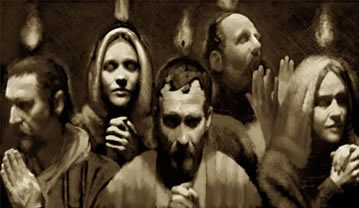
Footnotes
| ↑1 | cf. POPE PIUS X, Encyclical E Supremi “On the Restoration of All Things in Christ” |
|---|---|
| ↑2 | POPE LEO XIII, Divinum Illud Munus, n. 2 |
| ↑3 | cf. The Last Effort |
| ↑4 | cf. The Day of Difference |
| ↑5 | Annum Sacrum, n. 1 |
| ↑6 | Matt 24:14 |
| ↑7 | cf. Heb 4:9 |
| ↑8 | see Creation Reborn, Toward Paradise – Part I, Toward Paradise – Part II, and Back to Eden |
| ↑9 | cf. Wedding Preparations |
| ↑10 | cf. Key to the Woman |
| ↑11 | cf. Luke 1:35 |
| ↑12 | cf. Acts 2:3; 4:31 |
| ↑13 | cf. The Coming Resurrection; cf. Rev 20:5-6 |
| ↑14 | “The Spirit calls each of us and the church as a whole, after the pattern of Mary and the Apostles in the Upper Room, to accept and embrace the baptism in the Holy Spirit as the power of personal and communal transformation with all the graces and charisms needed for the up building of the church and for our mission in the world.” —Fanning the Flame, Fr. Kilian McDonnell and Fr. George T. Montague |

